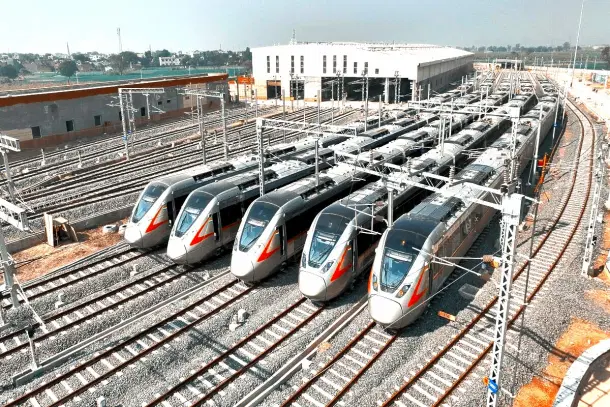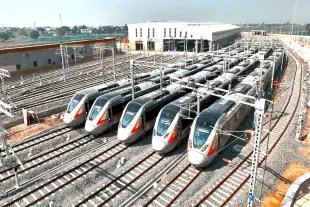Infrastructure
Delhi: Upcoming RRTS Corridors Set To Be Integrated With Delhi Metro Stations To Offer Seamless Travel For Commuters
Ankit Saxena
Mar 16, 2023, 11:36 AM | Updated 11:37 AM IST
Save & read from anywhere!
Bookmark stories for easy access on any device or the Swarajya app.


The Regional Rapid Transport System (RRTS) will integrate most stations on its three priority corridors under Phase-1, with the Delhi Metro network — to offer commuters an efficient travel experience without the need to exit RRTS stations along the way.
This will include the upcoming Delhi-Ghaziabad-Meerut corridor, which will connect four stations, including Sarai Kale Khan, New Ashok Nagar, Anand Vihar, and Ghaziabad, with its nearest Delhi Metro stations, according to a report by ET.
As part of this integration, the Sarai Kale Khan RRTS station will be linked with the pink line metro station, while the New Ashok Nagar RRTS station will be connected with the blue line.
The Anand Vihar station will offer connectivity to both the pink and blue lines, while the Ghaziabad facility will be connected to the Red Line of the Delhi Metro.
Similar interconnectivity will be proposed on the other two corridors of the rapid transit system — Delhi-Gurgaon-SNB-Alwar and Delhi-Panipat corridors.
The Delhi-Gurgaon-SNB-Alwar corridor will see four stations connected with metro stations at Sarai Kale Khan, INA, Munirka, and Aerocity.
The other corridor will be connected with the metro network at Indraprastha, Kashmere Gate, and Burari stations.
Further, the upcoming RRTS stations will not only connect with the metro, but will also be strategically linked to airports, railway stations, bus terminals and expressways.
By creating an integrated network, the RRTS aims to facilitate better ridership and ensure sustainable long-term transportation solutions.
According to an official from the National Capital Region Transport Corporation (NCRTC), "RRTS stations are being designed in a way to enable commuters to move from one mode of transport to another without exiting the station. Lifts, escalators and overbridges are being built to make this possible. This will be especially beneficial for women, the elderly, children, physically challenged and people travelling with heavy luggage," reports ET.
An official of the NCRTC highlighted that irregular service, overcrowding and the lack of last-mile connectivity are leading reasons for not utilising public transport.
To address these issues and offer a sustainable solution, a multi-modal integration of public transport modes would be necessary.
This integration will enable all means of public transportation to be accessible without stepping outside onto roads, consequently limiting traffic jams and congestion outside stations.
The 82 km Delhi-Ghaziabad-Meerut RRTS corridor is under construction and set to open in 2025, while the 17 km Sahibabad to Duhai priority section is expected to launch by April 2023.
The other corridor for Delhi-Gurugram-SNB-Alwar will be built in three stages.
The first stretch is from Sarai Kale Khan to SNB Urban Complex spanning 107 km. Then, the line will be extended by 33.3 km to reach Sotanala, with stops at Shahjahanpur, Neemrana and Behror. Lastly, the track will be extended by 58 km to reach Alwar in the third stage.
The third corridor of the rapid transit — the 103 km Delhi-Panipat corridor heads northwest from Delhi, linking the capital with towns including Murthal, Gannaur, Samalkha, and Panipat in Haryana.
There are 17 stations on the route, serving areas with many educational and hospitality facilities.





